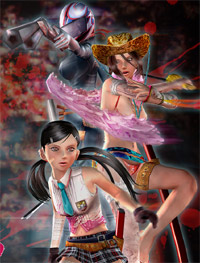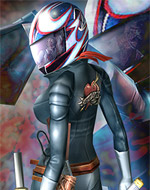Simple 2000 Series vol. 90: The Oneechanbara 2
 My copy of Oneechanbara 2 arrived the day before yesterday. I’ve only played it briefly, but enough to give some impressions. Really, it’s the same thing as the first game, but better-executed.
My copy of Oneechanbara 2 arrived the day before yesterday. I’ve only played it briefly, but enough to give some impressions. Really, it’s the same thing as the first game, but better-executed.
It looks and feels much, much better. Like Oneechanbara, most of the effort was clearly spent on making the characters appealing and fun to play. There are now three attack types: sword, hand-to-hand, and an alternate attack that varies from character to character. Aya (the one in bikini and cowboy hat) throws shuriken, her younger sister Saki dashes up to zombies and can pull off body parts, and the mysterious new biker has an old-fashioned shotgun that can be fired in any cardinal direction. Holding different directions modifies attacks: for example, holding back and hitting kick does a sweep, while holding forward and hitting kick with Aya makes her do a roundhouse kick that sends enemies flying. The different attack types can be comboed into one another, and it’s easy to get a feel for which attacks are good for starting or chaining and which are finishers. The combo system feels robust enough that it should be fun to try for high hit and kill counts, though I’m not very skilled with it yet.
The first game’s bloody-sword and ‘blood rage’ meters are still present, and you still clean the sword by flinging the blood from it. The biggest new addition to the gameplay is a tag-team system that lets you switch between different characters at any time. There seems to be a slight delay when it’s activated, so I’m not sure if it’d be useful to switch between them during a combo, but it definitely helps keep the levels more interesting than they were with a single character in the first game.
There are fewer enemies onscreen at any given time than in the first game. In exchange, all characters have more detailed models and textures, and better animation. The gore is more detailed this time around, too, and it tends to spurt and flow now instead of simply being spattered everywhere. For some reason the gore is now slightly more magenta instead of the first game’s crimson – I wonder why they made this change?
The engine seems to have been somewhat rebuilt, but some of the same weirdness from the first game is still present – for example, when you run for long stretches and go through several turns, the amount of analog stick you need to use for each successive turn feels inconsistent in the same way as the first game. The environments are more detailed and have much better texture work now, and look as nice or nearly as nice as the ones in Kunoichi/Nightshade. There seems to be slightly more variety this time around, too, and the levels are made up of more than simply long corridors. I can’t say much for the actual level design, though, as it still pretty much amounts to “kill X zombies in this room to get a key to Y door at the other end of Z level or sublevel.”
Aya‘s outfit is even more elaborate and silly than in the first game. Her boa is now feather instead of lace. Her cowboy hat has a couple of small ornaments on it. One of her gloves is shoulder-length and lacy at the top, while the other looks like an elbow-length kimono sleeve and has a..rope fringe thingy. Her bikini is now more scanty and resembles lingerie. Her belt resembles a kimono’s obi. She now wears a thigh-high, print, lace-top stocking on one leg. She has cheap-looking costume jewelery around her neck (including one long strand with a cross at the end) and around one ankle. She now has a double-jeweled navel piercing visible. And finally, instead of cowboy boots, she sports heeled pumps. The jumbled pieces make her look more than ever like she just took a tumble into a chest full of old stage costumes, but they actually sort of gel together into a campy whole.
The biker girl‘s black leather jumpsuit with its open front zipper is conservative by comparison. The wrinkles caused by how it rests on her frame and the heart emblem at the back tell me that the developers have improved at their texture work. I can’t remember the details of Saki‘s school outfit from the first game (she was a boss character and a hidden playable), but she seems to take a few more bumps and cuts in the course of her zombie-slicing than her sister. She has bandages large and small all over her body, and her too-small uniform blouse is permanently stained with splashed gore.
The characters seem to carry an intensity in their designs that they didn’t have in the first game, and the voicework is better-conceived and more frequently used. Tamsoft have refined what they created with the first game’s characters. It’s all exploitative, it’s all fairly ludicrous, but the game as a whole is, too, so it all works.
This is still not a “good” game. It still exists completely for the sake of its concept: cute female characters in skimpy, ridiculous outfits slashing up zombies. To that end, it fulfills its purpose more fully than the first game did. It’s unambitious, but I think the game is well-intentioned, and it’s easily one of the best games Tamsoft has ever made (which is really not saying much at all).
Update 1/9/2006 – more thoughts:
 I had a chance to sit down with Oneechanbara 2 for a while last night, and things are gelling a little better now. Here are some more thoughts & observations:
I had a chance to sit down with Oneechanbara 2 for a while last night, and things are gelling a little better now. Here are some more thoughts & observations:
– The tag-team character-switching is fun and well-balanced. When a player loses life, a few bars of the former level will remain in blue. Switching away to the other character will allow those blue bars to heal over time. Aya doesn’t have many unique abilities, but the leather-clad Reiko is a combo queen and her shotgun can decimate a crowd, and Saki has her wave-attack and dismemberment.
– The loading screen features cute little sprites of Aya and a blue-skinned zombie. Pressing the square button will make Aya slash the zombie vertically in half, with a small animation and plenty of blood. It’s a fun way to get through the load times (which seem to be shorter than those in the first game).
– There’s a cooperative-play mode in which each of two players controls one character. Only one player is in control at any given time, but hitting the character-swap button will make the player ‘tag out’ bring in the other player. I’ll need to try this out sometime.
– Level progression is better-paced and a little more varied than in Onee1. After the first level, there is less running for long stretches and more hopping from section to section, room to room. There are more of the fenced-in areas in which you have to kill a certain number of zombies in order to get a key item, and there are more key items to get.
– Level 3 uses the same trick Onee1 used in its third level: stage reuse. However, this time it’s a little more subtle and more forgivable. Level 2 is a shopping mall, and the stage boss is located in a bar inside the mall. Level 3 starts right where level 2 left off. The stage path goes through a couple of rooms that were part of level 2, but then takes the player into the second level of the mall, which has its own distinct layout and stores. While Onee1 used exactly the same level-pieces as multiple sections and floors of its hospital, Onee2 has enough detail and variety in its stages’ visual design that there’s a much better feeling of progress.
– The camera can be a handful during boss fights. It tends to be uncooperative at best when both the player and boss are near the walls of a room, especially when the player is facing away from a wall. It’s easier to manage than in the first game, between the lock-on and the new camera controls on the right stick, but there have been several moments during intense fights when it has just given up on me.
– It seems like it’s rather easy to become underlevelled. Each zombie you kill drops either a yellow sphere (which gives you experience) or a red sphere (which adds a little to your Blood Rage meter). I believe higher combos get you spheres that give more experience. It’s easy to run around the hordes of zombies that hang out in hallways – really, all zombies that aren’t required for getting at key items – so it’s easy to bypass wide swaths of possible experience orbs. And unlike in the first game, where your progress was often determined by what your attack statistic was, and therefore how quickly you could mow through the wall of zombies in front of you, Onee2’s action is friendly enough to skillful play that it’s difficult to tell if you’re underlevelled until a boss mops the floor with you. I’m not a fan of this sort of mechanic. I’m of the opinion that if experience levels are used at all, only deliberately abusive players should be able to throw off the balance of the action. However, I’m willing to forgive the problem here only because it’s fun to gain levels in Survival mode.
– The boss battles so far feel more like fair fights than those on Onee1. The first level’s boss feels sort of cheesy and can be offed pretty easily with cheese tactics, but level 2’s fight against a boss just as agile and vicious as the player requires skill at evasion and forward rolls. There’s nothing like sparring against a similar opponent for improving one’s skills. Level 3’s older-and-younger sister boss duo gave me so much trouble (between fighting the camera and me being underlevelled) that I gave up pending time spent in Survival. However, if I’d been levelled properly, skill and pattern-recognition would have carried the day.
Once again, I feel a little odd for giving Tamsoft and D3 praise for collecting ingredients I’d take for granted in any full-priced game. I think all this time I’ve been rooting for Tamsoft (and D3) to actually make a decent game. And I think they’ve done so with Onee2, certainly. Last time I said that I felt that Onee2 was still not a “good” game, but now I think that it is “good,” in the accepted, not-overgenerous sense. It’s still a long way from “excellent” or “great,” though.